Culinary culture is naturally formed from the process of living. To Vietnamese, not only does it bring flavors like others, but also conveys traditions and cultural values. No travelers have succeeded in their attempts to resist the temptation of Vietnamese dishes, including famous figures in the culinary industry such as Gordon Ramsay, Anthony Bourdain, Jamie Oliver, … Flavors of it have traveled the world, from bánh mì places in Japan to phở restaurants in the US. So what makes the cuisine of this small country so popular, yet so captivating and fascinating? Is it the depth of flavors? Or is it the rich history of its origin? Perhaps the best way to get a taste of it is through means of words. Let’s have a brief preview of the Vietnamese cuisine before you get the chance to experience it yourself, shall we?
I. Distinctive features of Vietnam’s culinary culture

Bun Bo Nam Bo | Source: Photographer Jakub Kapusnak (Foodiesfeed License)
Cuisine is an integral part of a culture. It is passed from one generation to the next. We grow up eating it, and it became a part of who we are. The act of cooking and eating traditional food is a method of preserve our culture. And because no two cultures, though may bear similarities, are the same, a diversity in different cuisines from around the world is created. Now, let’s have a look at what special characteristics of Vietnamese’s culinary culture that make it one of a kind.
1. The diversity of variations
Vietnam is an agricultural country with a typical monsoon climate and split into three particular regions: North, Central, South. It is that geographical differences that have form culinary variations between each one, creating diversity in Vietnamese cuisine. Each respected region has its own appetite expressed in different names, ingredients, cooking technique, color, … to how to present and eat. A bowl of pho in the south usually have bean sprouts, but not in the north. Yet no matter how different the variation is, you can still taste the quintessential elements within it: light, sweet broth, soft beef and the seducing scent of aromas.
Vietnamese are curious and would value the knowledge they have yet to grasp. They are also fast and flexible learners as well. With the process of globalization, they can easily adapt the unique trait of other cuisines from Korea, Japan, China, and European countries, … combining with theirs to create new dishes, various methods of cooking that are purely Vietnamese. Take, for example, a famous Indian dish: the curry. When imported to Vietnam, they were able to make the dish less spicy yet still savory. This is an element that contributes greatly to the diversity and harmony of Vietnamese culinary culture.
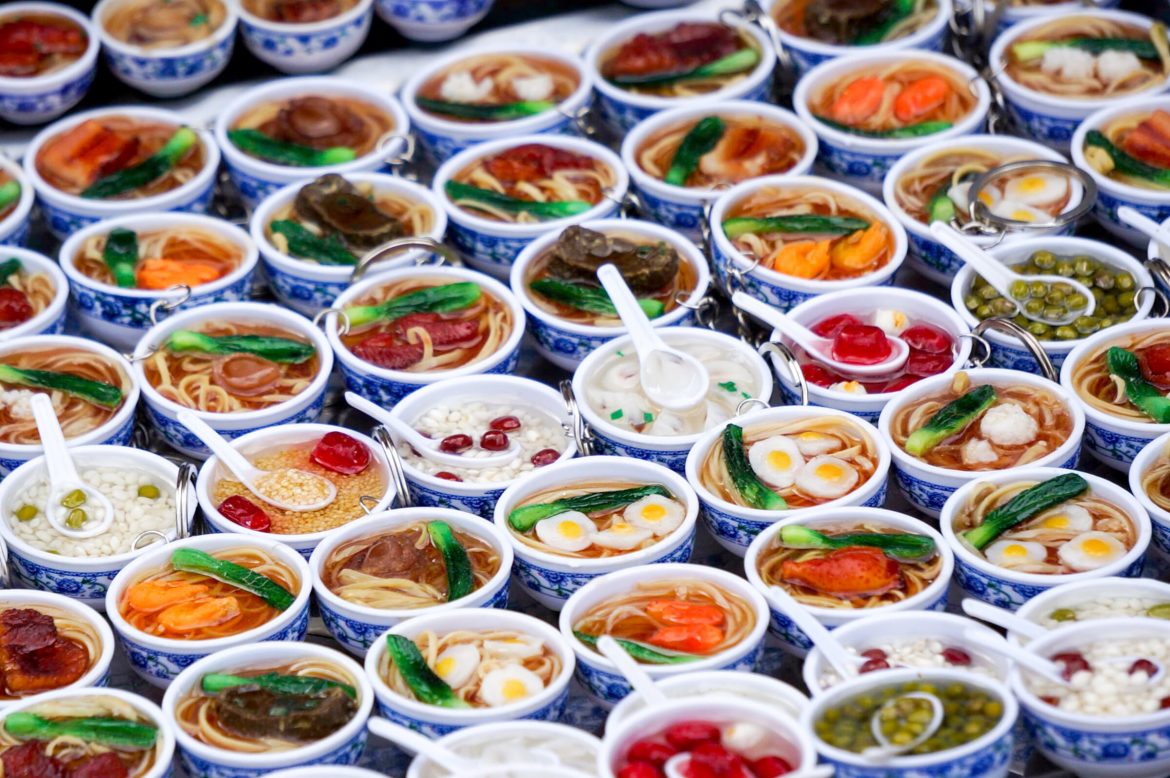
Variety of food cuisines | Source: Lux Travel DMC
2. Low quantity of fat within dishes
Vietnamese greatly respect the harmony within their dishes. A dish must have meet two requirements equally: tasty and healthy. In order to do this, they use what Mother Nature has offered. Nutritious, healthy ingredients such as vegetables and fruit are utilized extensively, to compensate the hero of the dish, and sometimes become the main ingredient. This is quite different from western cuisine, where meat is usually used as the center of the dish. Because of that, Vietnamese food has a surprisingly low amount of fat, grease, and oil, unlike western dishes which usually use too much meat or Chinese dishes with a bit excessive use of oil. You can enjoy Vietnamese cuisine to your heart’s, or stomach’s, content without being satiated and feel even better knowing that it’s one of the healthiest cuisine out there.
3. Fusion of various sauces and spices and other ingredients.
Since the very beginning of its time, Vietnamese cuisine has always had its own trademarks. There are no dishes that are too sweet, too salty or too fat, … However, every dish has its depth of flavor, so savory, yet very balanced, owing to the versatile usage of various sauces and spices.
Though the cooking process is fairly straightforward, Vietnamese chefs make good use of various spices such as salt, pepper, fish sauce, … accompanied by herbs like perilla, Thai basil, … to create flavors that are both sensational and harmonized, and to give the dish a dazzling presentation. The spices are also extremely diverse: chilling powder, seasoning, sugar, … They are used creatively and with care in order to fabricate complex favors which are the bases of Vietnamese cooking.
Dipping sauce also plays a fundamental role. No one knows since when did dipping sauce come into existence, but some say it appeared all the way back to the early days of Vietnamese cuisine and has developed with it, giving birth to an extensive variety of sauces and different methods of handling it. It has grown into something that is inseparable from a Vietnamese meal. Whether if it’s a frugal meal or a fancy restaurant dinner, cannot be completed with the absence of dipping sauce. Dipping sauces in Vietnam are varied thanks to the country’s history and geography, from fermented legume to fish or shrimp paste. Each region of Vietnam has its recipe for dipping sauces. Let’s look at fish sauce for example. While in the North, people often dilute the fish sauce with a water-vinegar infusion, along with some lemon drops and a bit of sugar, sometimes a bit of chili, garlic or crushed ginger… Southerners usually go with coconut water with fish sauce, lemon, and sugar. People from the middle region prefer to stick to the original flavor of fish sauce by adding just some lemon drops and sugar. This is just an example of one type of dipping sauce within hundreds more. The wide range of dipping sauces alone has made Vietnamese cuisine one of the finest. So important it is that it usually determines whether a dish is good or not.
Vietnamese food is a combination of multiple ingredients, from meat, fish, shrimp, to legumes, rice, herbs, … to give a composition of different tastes. Every ingredient plays an equal role, together, they create the soul of the dish.
4. Applications of philosophical importance
A dish, like every other element of life, must attain a balance. Vietnamese honor that balance, and apply ancient philosophy into their dish in order to do that. Every ingredient is used to create fragrance and flavor which response correspondingly while resembles the five elements of nature. There are five principal flavors: sweet, sour, salty, spicy and bitter. Also, Vietnamese eat using all senses: nose to smell the incredible fragrance, eyes to gaze on the colors and presentation, tongue to absorb the flavors, ears to listen to the satisfying crunchy sound, and sometimes hands to feel the texture and to take apart big chunks.
Principles of yin and yang are also applied to balance the properties of the dish. A dish with “cool” properties are served with “hot” spices. These elements are put to use to maintain the balance of our body. “Hot” ingredients must be counteracted by using “cool” ones in the process of cooking. Ingredients which clashes with one another must strictly not be used within a dish, which can cause harms to your health. So while preparing a dish, the cook must carefully and selectively choose the right components, for the sake of gastronomes’ health and taste palate, and maintaining the balanced respected by Vietnamese.
5. Order and arrangement of dishes
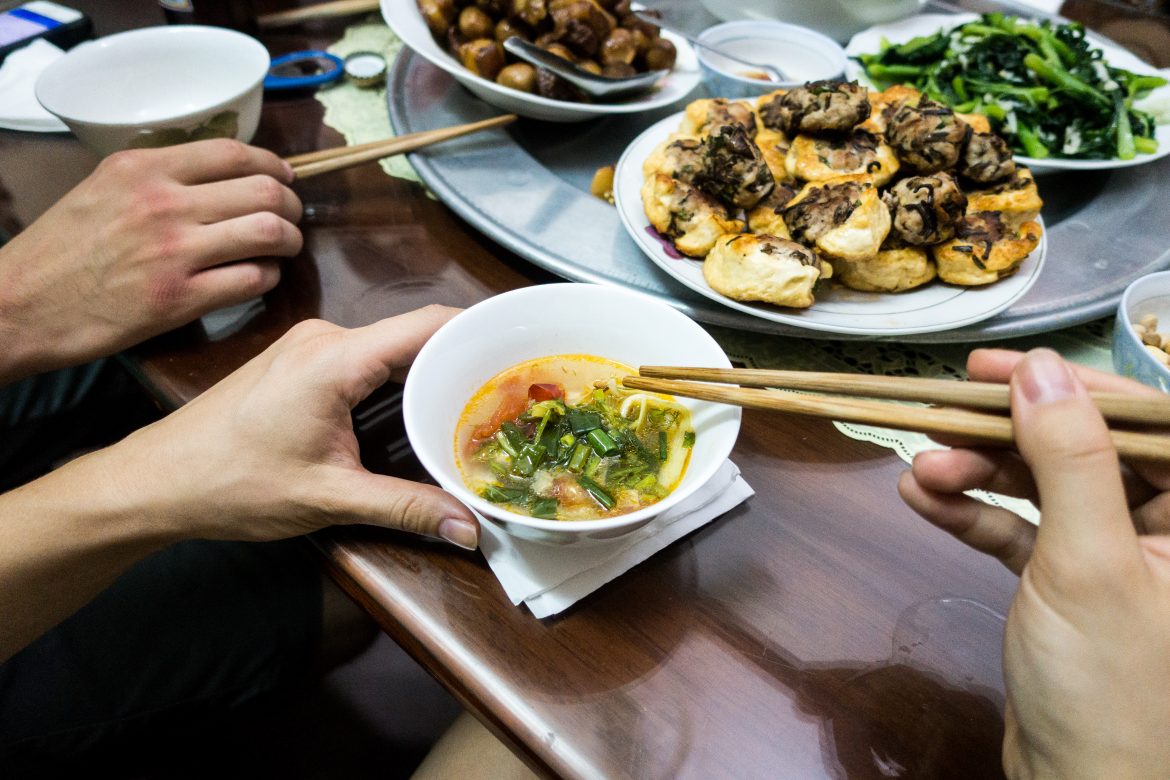
Vietnamese meal on a tray | Source: Photo by Jakub Kapusnak (Foodiesfeed License)
Though being a minor detail, this can be a culture shock for first-time foreigners in Vietnam. Unlike the western culture where each dish is served one after another, everything from appetizers to dessert is served at once, and in most household, on a round tray. Though keep in mind that you should eat in common order.
6. Usage of chopsticks
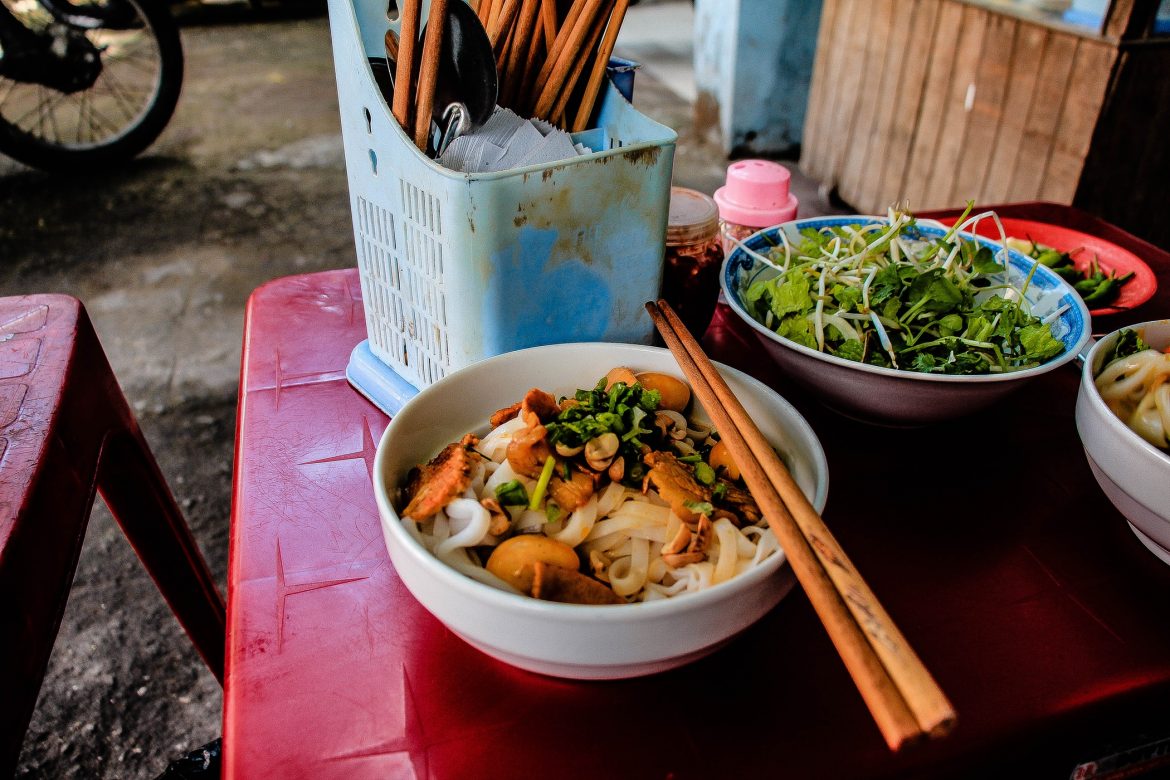
A kind of noodle in Danang | Source: Photo by René DeAnda on Unsplash
Some consider the usage of chopsticks to be the symbol of Asian cuisine. Using chopsticks is an art that non-native Asians need to take quite some time and practice in order to master it, instead of the usual knife and fork. It is one of the most outstanding traits of Vietnamese as well because in Vietnam and some other countries, using chopstick is a way to express care and goodwill to others. Simply but putting a piece of food into another’s bowl, though might not be sanitary, is a great way to show appreciation to them.
7. The communal aspect
The western cultures are usually in favors of individualism, which somewhat affect their way of eating, where each person has their own plate. The case is different in Asia in general, and Vietnam to be specific, the sense of community can be observed in an average meal. It is conveyed through the smallest details such as how bowl, pots, chopsticks, and trays are used. In a traditional Vietnamese meal, everyone would sit on a mat, surrounding a round tray where food is served. The way Vietnamese eat also express it. They share the same dipping sauce bowl, take food from the same plate, soup and rice from the same pot, … instead of devising into portions as in western cultures.
As a result of those special ways of eating, Vietnamese usually interacts with each other more in a meal. In addition, Vietnamese love to chat and make small talks during a meal. Parents ask about their kids’ school day, friends talk about their job, grandparents telling their children stories, … which bonds every individual, creating a lovely, warm atmosphere.
8. Hospitality during a meal
Before eating, Vietnamese usually “invite” others in the same table to eating, somewhat similar to the Japanese “itadakimasu”, but rather to invite others to start eating. This is one of much Vietnamese cultural beauty.
Vietnamese also love to invite guests to have a meal with them, or even invite them to join during a meal. More guests mean more bowls, chopsticks, … and everyone eats a bit less to spare some food for the guests. The host of the meal usually pick up food and put them in the guests’ bowl as a polite and generous manner. And keep in mind that the host never finishes before their guests. As a conclusion, a Vietnamese meal not only fun but also represent their hospitality
II. Most renowned dishes of Vietnamese cuisine
Possibly the trinity of Vietnamese cuisine, the jewels on the crown, pho, banh mi, and spring rolls are the most famous dish of this country. So well known, that pho has entered the Oxford dictionary on September 20th, 2007 and later, banh mi, on March 24th, 2011, becoming relevant among 600,000 existing English words. You can find these in every corner of Vietnam, from high-end restaurants to simple sidewalk with some plastic stools and tables. Even in other countries, around the globe from east to west, they are loved by everyone from common tourist to the most fastidious food critics. So what kind of magic did the Vietnamese put on their plate, or bowl, that just mesmerizes all taste buds? Let’s find out.
1. Pho
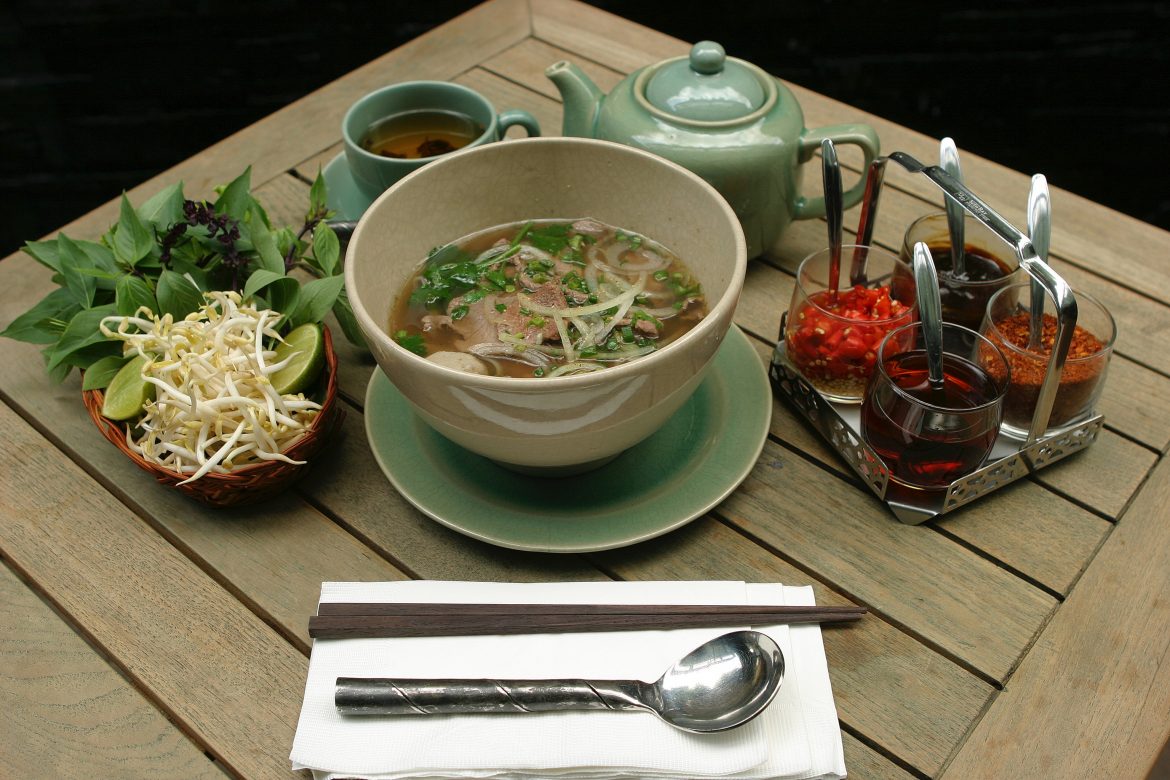
Pho Bo (Beef noodle) | Source: Photo by Lightscape on Unsplash
Ah yes, just a rustic, simple, rustic bowl of sweet, savory broth, some rice noodle, a few slices of beef and some herbs to go along. Yet without a single doubt, it has become the heart and soul, the symbol of Vietnamese cuisine.
Business Insider has published a list of 40 most delicious dish in the world that everyone should try at least once. And the first name of the list comes as no surprise: our beloved pho. And it’s not there for no reason. Behind a seemingly plain bowl of pho are the compositions of a number of meticulously selected spices and ingredients, along with time taking a process of preparation and cooking.
Pho has a place in every Vietnamese heart. It basically represents the Vietnamese culinary culture. You can find a pho restaurant everywhere you look in Vietnam, from the rural countryside to busy metropolis. You can enjoy this dish at any meal, whether it’s breakfast, lunch or breakfast, and even multiple times a day without feeling satiated.

Pho Bo | Source: Lux Travel DMC
Not only does pho satisfy the taste buds of Vietnamese, but also to foreigners, as if it a dish that they grew up with. There is something about pho that easily makes the first try an experience of a lifetime. The light broth infused by the essence of its ingredients. The soft, pearly white rice noodle. A slice of a perfectly, sometimes precooked, beef. The aromas of the herbs. All elements come together, compensate and perfect one another, creating a magical flavor that words can’t describe.
Vietnamese take great pride in this rice noodle dish. And when they travel to other countries, they bring it with them. Pho restaurant is now a common thing around the globe, yet still attracts quite a number of gourmets.
2. Banh mi
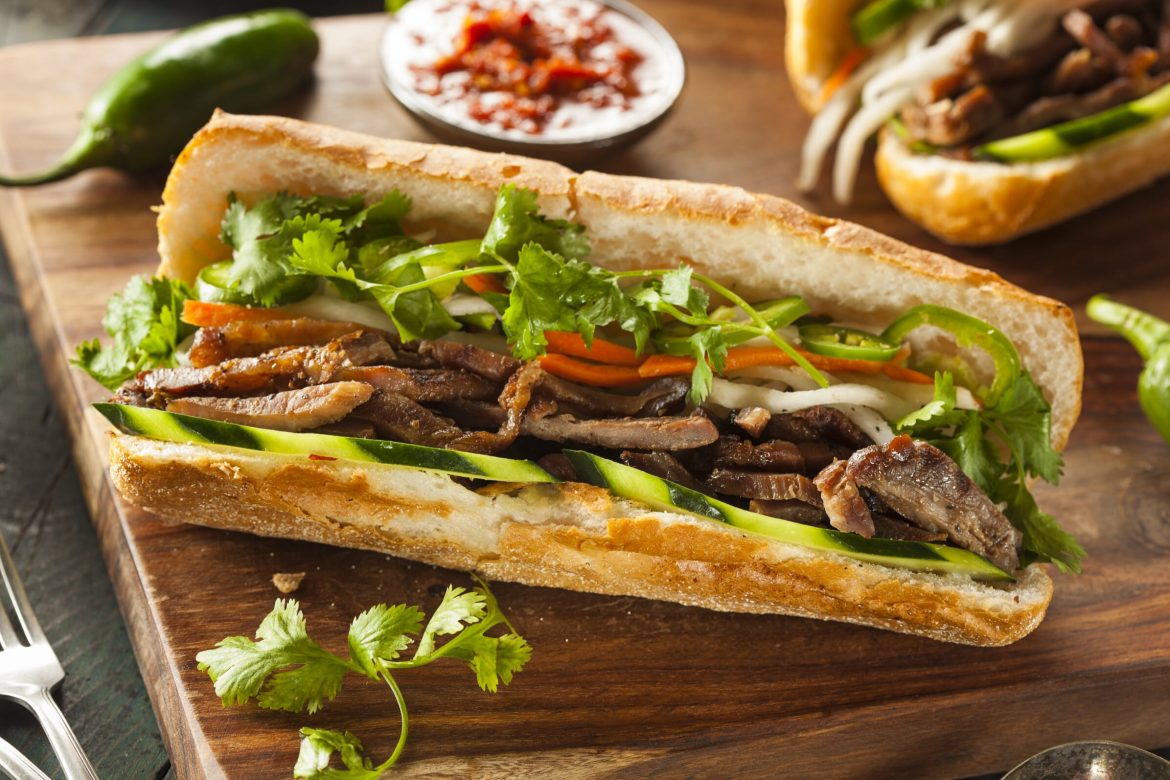
Banh mi | Source: Lux Travel DMC
Nothing reflects the nature of a cuisine better than its street food. If not, then why would Gordon Ramsay – a world-renowned chef awarded with 16 Michelin stars, willing to travel all the way to the far south of this small Southeast Asia country to get a taste and how to make a bowl of noodle on a tiny boat? Because street food is directly related to common people, who play a major role in the formation of a culture. And with pho as a symbol of Vietnamese cuisine in general, there is also banh mi which is the most outstanding representative of Vietnamese street food. It’s simple, uncomplicated, with little preparation required, and effortlessly fast to make. But don’t be fooled by how humble it is, as its influence is something comparable to that of pho.
Proving this is as easy as pie. Just look up on Google with the keyword: “banh mi”, you can find from hundreds to thousands of articles dedicated to its history and recipe. The strange thing is that most of them aren’t actually written by a native Vietnamese. The author can be a famous connoisseur or just a traveler. All they have in common is their recognition of banh mi as Vietnamese number 1 street food.
Banh mi is a phenomenon everywhere it reaches. And in Vietnam, all it takes is a minute walk from your hotel to the nearest alley to get a bite of this global food trend. Perhaps banh mi has become such an ordinary item within Vietnamese’s daily life that they have forgotten to make a standard recipe for it. Right in its birthplace, there are already so many different kinds, from pork skin banh mi in the south, to fish stick banh mi in the middle region, … Every banh mi maker has their own recipe, making a list of hundreds of variations that can only be found in Vietnam. Banh mi has followed Vietnamese footsteps to travel the globe, building famous brand such as Banh Mi Saigon in New York, Banh Mi Boys in Toronto, Banh Mi Ba in Prague, … Though you can even make your own banh mi at home, it will get nowhere near to taste as good as one from its home country.
3. Spring rolls

Nem, a kind of spring rolls | Source: Lux Travel DMC
In 2011, spring rolls made its appearance in CNN Travel’s “50 best dishes in the world”, becoming the runner-up and came in a close second only after pho for best Vietnamese dishes. Many are convinced that should there be a dish from Southeast Asia that is capable of rivaling Japanese’s finest – sushi, it would be spring rolls, based on the fact that it’s tasty, nutritious without putting you on weight.
Perhaps, spring rolls are one of the most “easy-going” dishes in Vietnamese culinary culture. You can either eat it as a quick, delicious meal to satisfy your rumbling tummy or enjoy as a fancy delicacy. It’s probably because of this attribute, with the fact that it has a signature flavor of North Vietnam or to be more specific, Hanoi, making it one of the most important, indispensable dish within the menus of every Vietnamese restaurant in the far West. The French named it “Rouleaux de Printemps” – the rolls of spring. Maybe This is probably because of the combination of colors of spring rolls. Just take a bite, feel the chewiness of those rice papers, the juiciness of the pork and the sweetness of the shrimps, dipped in savory sauce with a hint of spice, the freshness of raw vegetables, all come together to create a symphony of flavors.
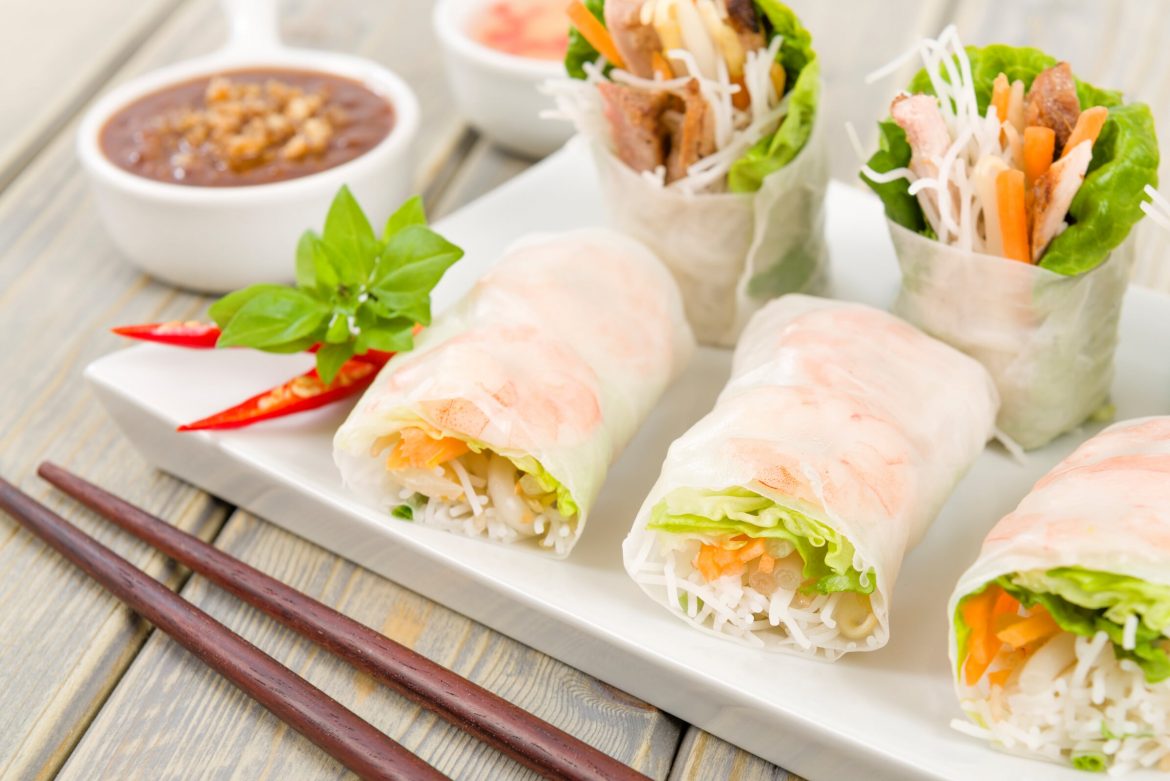
Spring roll | Source: Lux Travel DMC
Spring rolls without the presence of its dipping sauce would only half as good. The savory fish sauce deepens the flavor of the vegetables and fillings. From spring rolls, you can sense the balance of elements from ancient philosophy. It’s a gathering of the five tastes: the sweetness of the rice noodle, the savoriness of the eggs and meat, the heat of garlic and chili, the acridness of green bananas, the sourness of star fruits or pineapples, … yet each of them only has a specific tone that is just right. Should one flavor outpowers one another or become absent from the dish, the balance would be destroyed, leaving nothing but unsatisfied gastronomers.
There’s no specific recipe for spring rolls. It varies depending on the climate and geography of different regions, with each version comes with different fillings. Everyone can even select their own preferred fillings. Therefore, within the same meal, sharing the same name but every roll has its distinguished flavors, or even having different dipping sauces. This dish possesses every distinctive feature of Vietnamese cuisine. Hence, it’s not wrong to say, spring rolls is a true Vietnamese dish.
III. Different taste of Vietnamese cuisine by the region
1. Northern cuisine, dishes which surpassed time
The existence of the Red River Delta Civilization in the North of Vietnam dates back pretty far, all the way back to around the 2nd century B.C, bringing along an exquisite culinary culture. Northerners don’t opt for a particular spice or flavor. Instead, because of their special food palate, their dishes generally have a mild flavor, with a light touch of acerbity, but the colors are extremely vibrant. They also consume a fair amount of vegetables and freshwater fishery such as shrimp, crab, fish, clams and other shellfish, … Northern dishes usually have a harmony of flavors, not as forcefully spicy like the Middle region’s or as sweet as the South’s. This harmony is the foundation of the delicacy within Northern cuisine. Being rather reserved, Northern dishes adamantly follow the recipes of their predecessors, as they value traditions and customs, and they are convinced that the recipes are the best, because of the experience accumulate throughout generations.
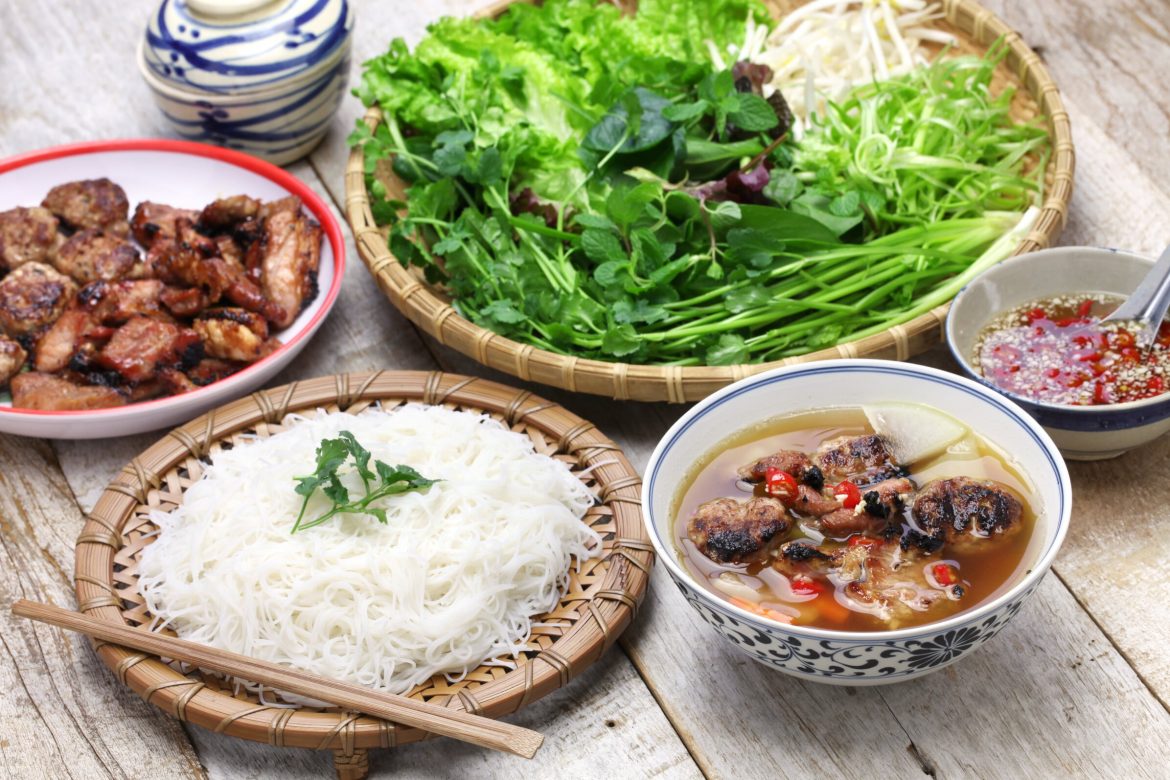
Bun cha | Source: Lux Travel DMC
With that said, don’t jump into conclusion that the cuisine of the North isn’t creative. As every family has their own recipe, hundreds of variations are brought about. The different shapes and sizes of the rice power strand decide whether it’s pho, bun or vermicelli, and the different process of cooking comes different dishes such as bun tron, pho cuon, ….
Hanoi is recognized as the bearer of Northern cuisine’s quintessence in the most comprehensive way, from delicacy such as pho, bun thang, bun cha, Vong village’s green rice flakes, banh cuon, … fully reflects every signature of North Vietnam’s appetite.
2. The central region, offering a taste of the imperial culinary
Moving down the map is the Central region, or the Middle region, where spicy is a distinction of its dishes. There’s a saying that sums up the culinary culture here: “chặt to kho mặn” which roughly translate as “big chops and heavy seasoning”. This is because the weather here isn’t favorable for its inhabitants, with heavy rains, scorching sunlight and frequent, unforgiving natural disasters. Due to these conditions, the good people there have adopted a habit of eating sparingly, in small bowls and dishes.
Central region inhabitants have a taste for spiciness and savoriness. Their dishes are eye-catching presented, with the main colors being red and dark brown. What special about the culinary culture here is the harmonization between two styles: imperial food and street food. Within this region, there is also the city of Hue – the former capital of the Nguyen’s dynasty, the final dynasty of Vietnam. As a result, dishes in this region are carefully prepared, cooked with complex techniques and possess fancy aesthetic. While the imperial cuisine is undeniably sophisticated, street food is rather frugal to compare with, yet it is more or less as incredible. This co-existence and parallel development have given Central cuisine its diversity. Bun bo Hue, mi Quang, cao lau, and hundreds of variety of banh such as banh dap, banh beo, … are dishes that have fully represented the culinary culture of the Central region.
3. Southern cuisine, exotic and diverse
Even though they weren’t blessed with such history like the North and the Central Region, the cuisine of the South is exceptionally exquisite. With perfect geographical conditions, food of the south not only retains special characteristics of other ethnic groups such as Champa, Chinese but also many other countries. In addition, it clearly shows the influence of the French during their colonization in the past, with the perfect example being Banh mi.
Southern dishes are generally sweet, juicy with the use of sugar, coconut juice and other exotic ingredients and spices from Mother Nature. Moreover, with abundant natural resources and their open-minded personality has created diversity in their cuisine. From unusual ingredients to lesser-known cooking techniques, … form trademark dishes of the South. From sauces such as snakeskin gourami sauce, three-striped crab sauce, … to out-of-this-world dishes such as fried field-mouse soaked in coconut juice, stir-fried large flying fox marinate with bean curd cream, coconut worm, date palm worm, hay-grilled naked snakeheads, …
4. The cuisine of ethnic minorities – the hidden gem
Vietnam is home to more than 54 ethnic minorities, each of which possesses its own unique traditions and customs. Consequently, this leads to various different culinary culture. Though they lack the diversity in ingredients due to living in remote areas such as mountains, deep forest, …. It would be wrong to underestimate their cooking techniques. Take, for example, the five-colored sticky rice. Colors used to dye this dish is found in local flora: white from the glutinous rice, red from gac fruit, green from pineapple or raspberry leaf, purple from com den or sau leaf, … Smoked buffalo is another example: buffalo meat must be marinated with a complex concoction of various spices: jungle pepper, diced chili, special wine, cape yellowwood seeds, … then hanged and smoked day after day for two long months. Many other dishes such as pa pinh top, black banh chung, grilled piglet with Vietnamese curry leaf … To conclude, they all reflect complex and unconventional cooking methods, taking part in diversifying Vietnamese cuisine.
IV. Some facts about the Vietnamese cuisine
As you can see at this point, Vietnamese cuisine is among the most amazing. Yet the surprise doesn’t stop there. There are facts that might still come to most travelers as a shock, and the following is just to name some specifics:
1. Flavorful breakfast to start the day
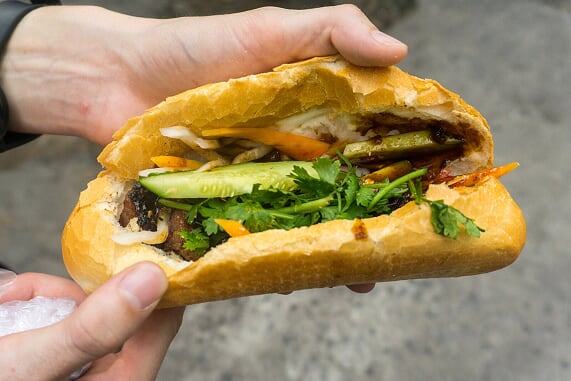
Banh mi | Source: Lux Travel DMC
Breakfast is the most important meal of the day, no doubt. Vietnamese have the same idea. It provides energy for you to make through the day, thus, Vietnamese rarely skips breakfast. Foreign travelers are especially impressed with how Vietnamese have their first meal of the day in moderation and how nutritious it is.

Bowls of steaming hot sticky rice | Source: Xoi Yen Ha Noi
Scarcely do travelers find Vietnamese have cereal, salad or sweet food for breakfast. Instead, they take their time to enjoy a big, wholesome meal, with banh mi, pho, rice, congee or a bowl of steaming hot sticky rice with dried pulled or braised pork, eggs, … to start the day right. Housewives in Vietnam also get up very early to prepare dishes for their family so they can make the most of the time their family are together.
2. Having dessert for snack meals
Some humorous travelers take on Vietnam’s climate as “unforgivingly hot”. It’s more than true, but the Vietnamese have learned to adapt to this. They came up with refreshing desserts such as sweet soup or gruel, juice, mixed yogurt, … Travelers coming to Vietnam will get the chance to enjoy these, and some dishes that really struck an impression are sweet bean soup, Thai sweet gruel, douhua, …
In common sense, these dishes are only used in small portions after the main dish, but the case is different in Vietnam. Vietnamese tend to have these as afternoon snacks, in small shops or vendors. This is why traveling to Vietnam requires a pot belly to experience all of it.
3. The coffee culture
Coming second only to Brazil in the field of coffee production, it’s not much of a surprise to see foreigners find the culture of this signature drink in Vietnam a bit odd. Being exquisitely flavorful, Vietnamese coffee will utmost certainly be a highlight of travelers’ holiday.

Iced coffee with milk | Source: Photo by frank mckenna on Unsplash
Iced coffee with milk is a generally popular Vietnamese drink. In every town or city, foreign travelers can easily find a decent coffee shop on the street. It’s not a tough task to see Vietnamese enjoying their cup of black or brown coffee on every street. No need for big, fancy coffee shop, but only some plastic stools and a couple tables, and you’ll get a decent place to sip some caffeine with a view of the old quarters, or the busy streets in the breezy weather. Also, Vietnamese don’t waste their weekend morning by waking up really early to stop by a coffee shop for a chat with some friends or to read a good book.
4. Blood soup, abnormal yet palatable
Vietnamese cuisine is a compound of many dishes, varied from delicate, even high-class dishes such as pho, to unusual and exotic dishes such as sandworm pancakes. Though not as notorious as the infamous balut, blood soup is quite an unorthodox dish that is familiar to every born-and-bred Vietnamese.
This particular dish is made of animal blood, specifically poultry, pig, goat, …. In Vietnamese tradition, when butchering one of these animals, in order to make the most of it, as a way to honor its sacrifice, blood soup is made. Making a perfect bowl of blood soup requires experience as well as refined techniques. In every bowl of blood soup, there is diced pre-cooked meat, fish sauce, herbs, peanut, …
Not every foreigner, or sometimes even Vietnamese have the guts to taste this dish, can only know about its taste through description: savory with a bit of acidity. In many local regions, this dish is made with other delicacies from meat to celebrate a special event or festival
5. The widespread use of fish sauce
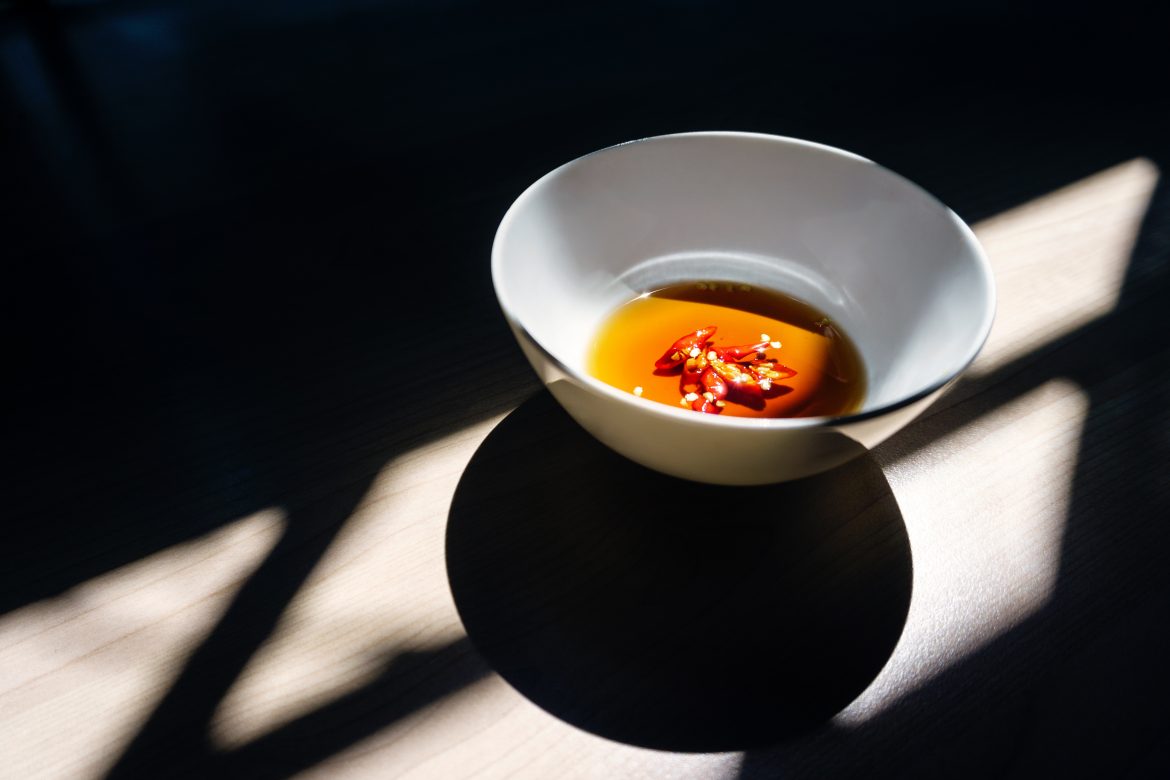
Fish sauce | Source: Photo by Percy Pham on Unsplash
From reading the above, you can understand how important of a role fish sauce plays. It is and has been the key spice and sauce to Vietnamese dishes. You can’t call it a Vietnamese family meal without a small bowl of fish sauce in it.
Fish sauce is made by brewing anchovies and salt until fermented. At the right point of time, the base sauce won’t retain such an overpowering flavor, but rather a pleasant taste. The sauce is elevated even more when combined with other ingredients.
Fish sauce is the perfect dipping sauce for many Vietnamese dishes such as spring rolls, bun cha, sweet and sour grated salad, … Were fish sauce to not exist, Vietnamese cuisine wouldn’t be able to stand where it is now among others.
6. Culinary tours available in Vietnam
According to a survey conducted by the US Travel Association, a quarter of leisure travelers agreed that local food is a priority for choosing a destination. And because of how diverse Vietnamese cuisine is, and how strong its connection to the country’s history is, it is recommended to take a culinary tool to experience the most of what it has to offer. A culinary tour, or a food tour, allows you to get a better inside look into what, when, where and how locals eat, as well as their delicacies and their backstories. Some tours take you to landmarks, as normal tours do, but also focus more on local restaurants and locations similar to such. Others include cooking workshop in its itinerary, providing you with hands-on experience. A local guide will also be there to explain what the dish is about: its ingredients, its origin, and history, what role it plays in the local culinary culture, …
A quick Google search can give you numerous information about culinary tours in Vietnam. From food taste culinary and sightseeing tours to tours with cooking classes, food and culture exploration tours, … If this is too overwhelming, don’t worry. Our company – Lux Travel DMC, is there to provide you with the best high-end experience culinary tours. We offer a variety of tours from half-day gourmet tour sampling to 16-day tours that allow you to feast on Vietnamese cuisine’s finest. We are dedicated to providing our customers with nothing but satisfaction, and gastronomes are no exceptions. Come with us, and dine in some of the finest, most exceptional restaurants in this country, and have an experience of a lifetime for you and your taste buds.
About Lux Travel DMC
Lux Travel DMC offers high-end packages in Vietnam, Laos, Cambodia, Myanmar and Thailand. The company has 15 years of experience in travel industry and specialize in high-quality vacation. To bring the most authentic travel experience to the customers, Lux Travel DMC has the experts with thorough knowledge about all aspects of travel and care skills. You will be supported by the team in many different languages: English, French, German, Italian, and Spanish.
Contact Us:
- Address: No.456 Lac Long Quan Street, Tay Ho District, Hanoi, Vietnam
- Phone: (+84) 4 3927 4120
- Email: sales@luxtraveldmc.com
- Hotline: +84-336-276-996
- Website: https://luxtraveldmc.com
Plan Your Trip Here!
